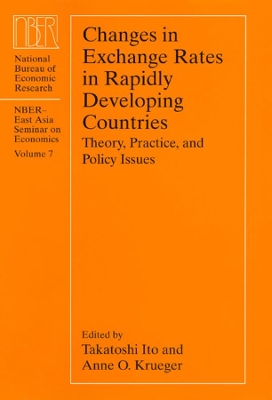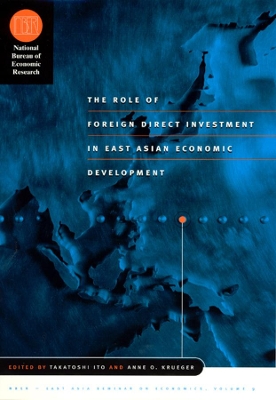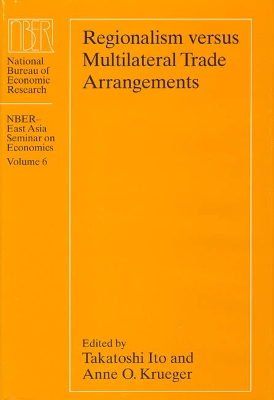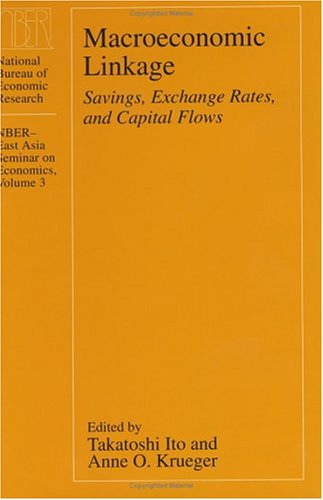National Bureau of Economic Research - East Asia Seminar on Economics
1 primary work • 5 total works
Volume 7
Changes in Exchange Rates in Rapidly Developing Countries
by Takatoshi Ito and Anne O. Krueger
Published 15 April 1999
The exchange rate is a crucial variable linking a nation's domestic economy to the international market. Thus choice of an exchange rate regime is a central component in the economic policy of developing countries and a key factor affecting economic growth. Historically, most developing nations have employed strict exchange rate controls and heavy protection of domestic industry-policies now thought to be at odds with sustainable and desirable rates of economic growth. By contrast, many East Asian nations maintained exchange rate regimes designed to achieve an attractive climate for exports and an "outer-oriented" development strategy. The result has been rapid and consistent economic growth over the past few decades. This volume explores the impact of such diverse exchange control regimes in both historical and regional contexts, focusing particular attention on East Asia. The book should be a useful reference for scholars and policymakers.
Considering the examples of Australia and the Pacific Rim, Growth and Productivity in East Asia offers a contemporary explanation for national productivity that measures contributions not only from capital and labor, but also from economic activities and relevant changes in policy, education, and technology. Takatoshi Ito and Andrew K. Rose have organized a group of collaborators from several Asian countries, the United States, and other parts of the globe who ably balance both macroeconomic and microeconomic study with theoretical and empirical approaches. Growth and Productivity in East Asia gives special attention to the causes for the unusual success of Australia, one of the few nations to maintain unprecedented economic growth despite the 1997 Asian financial crisis and the 2001 global downturn. A new database comprising eighty-four Japanese sectors reveals findings for the last thirty years of sectoral productivity and growth in Japan. Papers focusing on Indonesia, Taiwan, and Korea also consider productivity and its relationship to research and development, foreign ownership, and policy reform in such industries as manufacturing, automobile production, and information techno
The Role of Foreign Direct Investment in East Asian Economic Development
by Takatoshi Ito and Anne O. Krueger
Published 15 July 2000
The international flow of long-term private capital has increased dramatically in the 1990s. In fact, many policymakers now consider private foreign capital to be an essential resource for the acceleration of economic growth. This volume focuses attention on the microeconomic determinants and effects of foreign direct investment (FDI) in the East Asian region, allowing researchers to explore the overall structure of FDI, to offer case studies of individual countries, and to consider their insights both general and particular, within the context of current economic theory.
v. 69
Regionalism Versus Multilateral Trade Arrangement
by Takatoshi Ito and Anne O. Krueger
Published 15 October 1997
The open multilateral trading system after World War II is regarded as a key ingredient in the rapid economic development of the entire world. Especially in Hong Kong, Korea, Singapore, and Taiwan, exports increased dramatically, both in absolute terms and as a percentage of GNP. In the 1980s, however, preferential trading arrangements (PTAs) began to emerge as significant factors affecting world trade. This volume contains 13 papers which analyze the tensions between multilateral trading systems and preferential trade arrangements, and the impact of these tensions on East Asia. The first four chapters introduce PTAs conceptually and focus on the unique political issues that these agreements involve. The next five essays present more direct empirical analyses of existing PTAs and their economic effects, primarily in East Asia. The last four papers concentrate on the outcomes of individual East Asian nations' trading policies in specific instances of preferential agreements.
This volume explores East Asia's macroeconomic experience in the 1980s and the economic impact of East Asia's growth on the rest of the world. The authors explore the causes of capital flows, changes in trade balances, and exchange-rate fluctuations in East Asia and their effects on other countries. These 14 papers are organized around four themes: the overall determinants of growth and trading relations in the East Asian region; monetary policies in relation to capital controls and capital accounts; the impact of exchange-rate behaviour on industrial structure; and the potential for greater regional integration. The contributors examine interactions among exchange-rate movements, trade balances and capital flows; how government monetary policy affects capital flows; the effect of exchange rates on industrial structure, inventories, and prices; and the extent of regional integration in East Asia.




